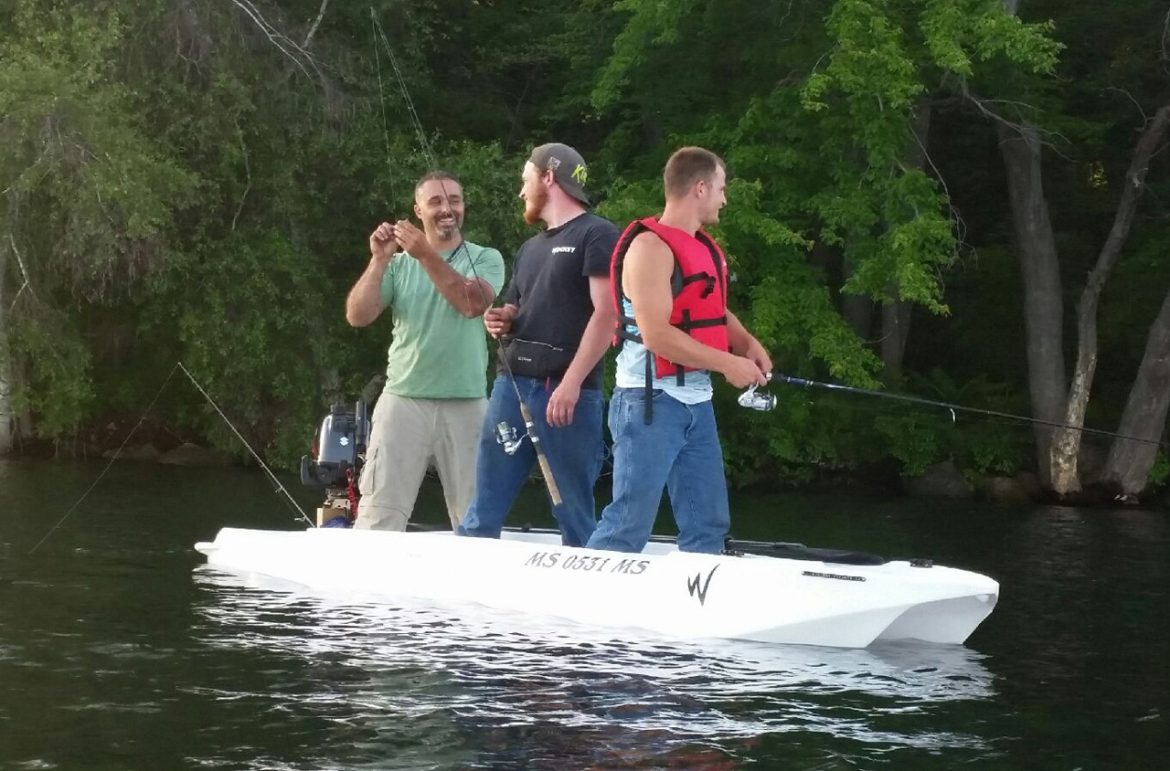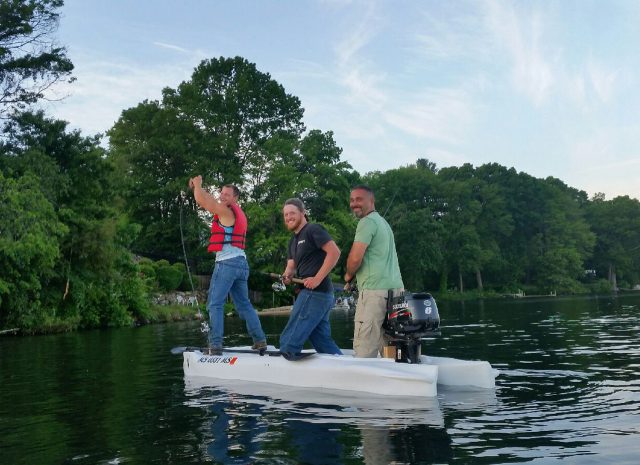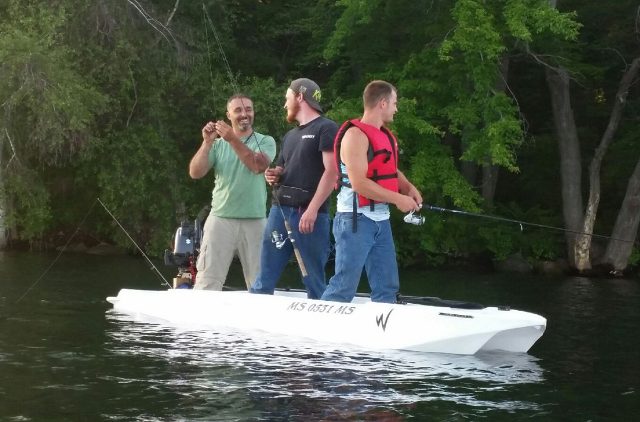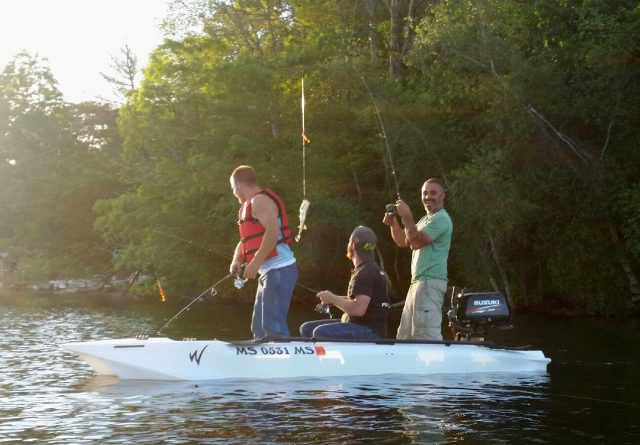Updated March 26, 2025
MAXIMAL KAYAK STABILITY ACHIEVED THROUGH OPTIMAL DESIGN
Three anglers fishing standing in an S4 Read the full story »
Click images to enlarge
The world’s most stable kayak is WAVEWALK’s S4
What makes the S4 the most stable kayak? – There is no other kayak that offers anything comparable in terms of stability: Three anglers can fish standing in full confidence and comfort in an S4, thanks to its unrivaled stability. Three adult paddlers standing in it can paddle with ease and confidence. The S4 is so stable that it can easily go in 2 ft waves, and it is rated for a 6 HP outboard motor, which is why it is the only kayak that’s classified as a multihull boat by US Coast Guard (USCG) standards. Indeed, many S4 owners use it as a an ultralight seaworthy microskiff. This kayak that doubles as a high performance car-topper boat is far more stable and seaworthy than the biggest and widest fishing kayak out there, and it’s even more stable than many large size Jon boats and microskiffs.
Watch this video that demonstrates what ‘Unrivaled Stability’ looks like –
CONTENT
- What is Stability in kayaks?
- How to Maximize a Kayak’s Stability and its user’s Balancing Capability?
- The Importance of Lateral Stability
- Primary (Initial) Stability and Secondary Stability
- Tunnel Hulls don’t necessarily offer more stability
- Outriggers for Kayaks – How much stability do they add?
- CONCLUSION: SUPER STABILITY
About this article –
The purpose of this article is to elucidate the principles of Kayak Stability, and to explain what enabled Wavewalk create the world’s most stable kayaks for fishing, paddling, and motorizing, based on the invention described in US utility patent number 6871608 entitled ‘Twin Hull Personal Watercraft’.
Before reading it, we recommend that you watch this short demo video showing Absolute stability offered by the W720 kayak-skiff:
The W720 twin-hull kayak is so stable that it is rated for a 3 HP outboard motor. In fact, the W720’s stability is good enough for it to be powered with more powerful motors, and indeed, it is shown driven with 6 HP motors. However, Wavewalk limits the power rating of the W720 kayak-skiff to 3 HP (practically 2.5 HP) mainly because it makes more sense for people who want to go faster to use the seaworthy S4, which is rated for 6 HP.
WHAT IS KAYAK STABILITY?
Stability is defined as resistance to change, deterioration, or displacement, and it is synonym to reliability and dependability. In naval terms it means the ability of a watercraft to maintain equilibrium or resume its original, upright position after tilting on its side as a result of the action of waves, wind, or its passengers in case of a small craft such as a kayak.
This article discusses Lateral Stability and not directional stability namely tracking, which is discussed in other articles on this website.
WHY IS LATERAL STABILITY SO IMPORTANT?
Lateral stability is a key factor in kayaking and kayak fishing, since it increases the safety and well being of kayakers and kayak fishermen, as well as their performance.
This article explains the basic terms used in kayak design in the context of stability, and how the patented Wavewalk kayaks deliver lateral stability that exceeds the stability that any other kayak and small boat offers.
Before going further, the author of this article would like to stress that in his opinion the idea of relying on the kayaker’s skills in performing the ‘Eskimo Roll’ as a primary resource in safety terms has failed since the overwhelming majority of people who use kayaks in recent decades have chosen to ignore it, and rightfully so. The reason for this is that kayak rolling is basically a method of recovery and not a means of prevention. This explains why most manufacturers and kayakers apply common sense and prefer to prevent accidents rather than focus on unreliable recovery techniques. In other words, the world has opted for more stable kayaks and dumped the idea of kayaks that can be rolled by their users.
PRIMARY (INITIAL) STABILITY AND SECONDARY STABILITY
Primary (Initial) Stability refers to what the kayak feels like when used in flat water – Does the kayak convey to its user/s a basic sense of confidence as far as its stability goes?
Secondary stability refers to how easy it is for the user to balance, stabilize, and control their kayak once it’s already heeled (tilting), or generally speaking in all adverse conditions where the kayak is either constantly and/or suddenly being tilted on its side, either because of an external force or as a result of something that a user did.
Both primary and secondary stability are important, but while primary stability relates mainly to how the kayak passengers feels before a disruptive event occurs (and these events always occur), while secondary stability is what mostly affects their safety and performance in paddling and fishing.
Any further discussion about these terms would be lacking in substance without determining who’s inside the kayak, since the passenger weighs several times more than the kayak itself, and he/she is the key factor that affects the way the vessel reacts to destabilizing forces, whether external or internal –
Flat water racing kayaks can be as 18″ or 19″ narrow, while some fishing kayaks can be over 40″ wide. The first are designed for use by highly skilled and relatively small sized kayakers that can’t stabilize such kayaks without constantly keeping their paddle in the water, while the latter are required to offer good stability mostly to bigger and less skilled paddlers that occasionally happen to be fighting big and strong fish, and often stand up in their kayak when paddling and fishing if they happen to be using a Wavewalk fishing kayaks.
Therefore, primary stability has much to do with comfort, and secondary stability is what helps you from getting your kayak overturned in real life conditions, when an external force or your own actions work to shift the kayak’s Center of Gravity (CG) sideways, and tilt dangerously.
HOW TO MAXIMIZE KAYAK STABILITY?
Physical Stability and Balancing Capability
Some vessels deliver good initial stability by virtue of their being very wide. Other, small vessels are narrow, and they deliver stability by offering their users means to balance themselves effectively. An example for the first type of vessels are big Jon boats, skiffs, and catamarans. Personal Watercraft (PWC) nicknamed jet-skis are an example of small, high-performance boats that overall are very stable due to the fact that they offer their users excellent means to balance themselves effectively while they ride the saddle-seat at the center of the deck and hold the steering bar. In this sense, PWC are the aquatic equivalent of All-Terrain Vehicles (ATV), snowmobiles, and motorbikes.
Similarly to Personal Watercraft, Wavewalk kayaks feature a saddle seat that allows their users to balance themselves more effectively than all other types of seats found in other kayaks and boats. When Wavewalk kayak users ride their kayak’s saddle seat, they benefit from a maximal degree of control over themselves as well as over the kayak that they operate, and they enjoy both full comfort and confidence that cannot be attained in other kayaks, and even in many large size boats.
In a Wavewalk kayak, the user riding the saddle is supported by a large-size hull on each side. These twin hulls provide buoyancy, namely load bearing capacity which provides resistance to change when the user’s weight shifts sideways, and they deliver this buoyancy where it is the most effective, namely on the kayak’s sides, which are also the user’s sides. In contrast, other kayaks have most of their buoyancy distributed along their center line, where it is ineffective in terms of balancing and overall stability, both primary and secondary.
The Kayak’s Center of Gravity (CG)
The most effective stabilization method is applied in the patented Wavewalk kayaks, and it consists of minimizing the destabilizing effect of the kayaker’s own weight on the kayak. In order for this method to be effective, this weight needs to be applied as low as possible, preferably much lower than the waterline, that is below the water surface.
In traditional, monohull, sit-in kayaks the designer who wants to apply this method would try to lower the kayaker’s center of gravity (CG) by designing a deeper hull and placing the kayaker’s lowest parts as closely as possible to the bottom of the kayak.
In this case the designer’s efforts will be limited by the fact that traditional kayaks must have a shallow draft or else they won’t offer sufficient free board, and by the modern kayaker’s need for a padded and/or high seat, which places him/her higher than the hull’s lowest point.
This approach is mostly passive and regards the kayaker as a load having certain physical properties such as height, width and weight, and little to no capability to balance their kayak.
Applying this method of stabilization in sit-on-top (SOT) kayaks, which have gained a big part of the kayak market today is not possible because the SOT kayaker must sit several inches above waterline in order to enable water to drain down from the deck through the scupper holes, and try to prevent the deck from being often flooded by water coming from below through those holes.
Wavewalk kayaks are not restricted by issues of free board and draft, and they enable the kayaker to apply his own weight directly to the lowest point of each hull through his feet, especially in the standing or riding positions, in which the user’s legs carry most of their weight.
This approach applied in Wavewalk kayaks takes into account the kayaker’s physical attributes such as size and weight, as well as their physiological attributes namely their natural propensity and obvious capability to balance themselves naturally through the use of their legs, feet etc. Being the natural approach it is also the most ergonomic and effective one in stability terms.
Wavewalk kayaks and boats feature a saddle seat that’s similar to the saddles of personal watercraft (PWC), all-terrain vehicles, snowmobiles and motorbikes. This high-performance saddle enables the rider to benefit from maximal balancing capabilities, in a natural and intuitive way, while causing no back pain at all. The user’s unconstrained range of motion contributes to their well being as well as their ability to react effectively to destabilizing events, and balance their kayak effortlessly.
Demo video of the tiny W500’s stability in the Riding Position
The W500 (2009-2021) is now replaced by the bigger and more stable W720
One Simple Question You Must Ask Yourself:
For a clearer understanding of this point we recommend that the readers ask themselves the following question: -“Would I consider sitting in the traditional, L kayaking position when surfing, riding a horse, riding a snowmobile, an all-terrain vehicle (ATV), a jet ski etc.?”
The obvious answer would be “Never!“, naturally, and this is because all these sporting activities require active and efficient balancing, which is best achieved through the use of our legs, and for this purpose the traditional L kayaking position is worthless.
The traditional and ineffective approach – a wider kayak: XL, XXL…
The most common solution for increasing kayak stability is making kayaks with a wider beam, although the wider the kayak the less efficient it is for paddling. Those extra wide fishing kayaks are practically impossible to paddle to any reasonable distance, and they are even hard to move with a pedal drive.
Improving initial lateral stability is achieved by placing maximum buoyancy as far as possible from the kayak’s longitudinal axis. In monohull kayaks (both regular and ‘tunnel’ hulled), this is achieved through a wider beam, but even the widest monohull kayak still has most of its buoyancy placed along its longitudinal axis – as shown in Figure 2, where this buoyancy is wasted as far as contribution to stability is concerned:
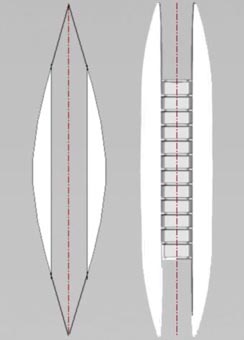
1. Monohull 2. Wavewalk Twinhull
The above figure shows a monohull kayak (left) and a Wavewalk kayak (right) of identical length and width – Both kayaks are viewed from the bottom. The vertical, interrupted lines represent the center line of each of these two different kayak designs.
The white colored areas represent the buoyant parts in the kayak that are distant enough from its longitudinal axis to contribute to its stability.
Although the monohull kayak on the left is wide for its length, the white areas in it still make just a small part of its overall volume. In contrast, the white areas in the Wavewalk twinhull kayak on the right represent 100% of its total volume, and they are several times bigger than the white areas in the traditional kayak.
In sum, all monohull kayak designs (SIK, SOT and Tunnel hull) allocate just a small part of their buoyancy for effective stabilization, while the Wavewalk design makes use of all its buoyancy for this purpose.
This is how the Wavewalk kayak is capable of offering its unrivaled initial stability, and some of its legendary secondary stability, which is complemented by its unique ergonomic design.
Hard Chines – A Partial, Limited Assistance
Another common solution for increasing lateral stability is through minimizing the kayak’s propensity for rolling and overturning by increasing resistance to rotary motion: This can be achieved by giving the kayak a form that generates resistance from the water through the need to displace water when the kayak is tilting on its way to roll. This method is useful mainly in dealing with primary stability.
Comparison Of Three Kayaks’ Cross Sections
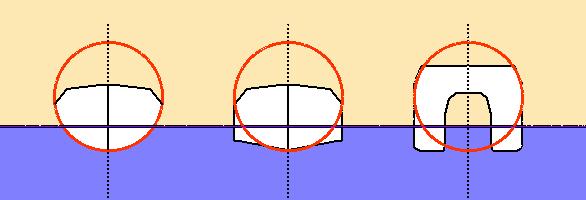
Kayak A (Left): The bottom part of this traditional kayak’s cross section is round, and such a kayak would be called ’round bottom’ (think of a virtual wheel, or a barrel). Such kayak offers practically no resistance to rotary motion, and therefore is particularly unstable.
Kayak B (Middle): The bottom part of this traditional kayak’s cross section is angular, and such a kayak would be described as having ‘hard chines’. The chine is the nautical term for the line where the side and bottom of the hull intersect. Such kayak would have to displace some water when in lateral rotary motion and thus offer more resistance than kayak A, and therefore would be more stable than kayak A.
Kayak C is a Wavewalk Kayak (Right): The bottom part of this kayak must displace big quantities of water when heeling (tilting) and forced into rotary motion, and thus it offers maximal resistance to rotary forces, I.E. the most resistance to tilting and rolling.
TUNNEL HULLS
A tunnel hull is a name given to a monohull vessel with typically one ‘tunnel’ going along its longitudinal axis – from bow to stern. The tunnel is submerged, including its ‘ceiling’ (top side). Tunnel hulls have been in use since the late part of the 1870s, and the concept has already been implemented and tested in various canoe and kayak designs over the years.
Figure 4: Cross Sections of Regular and Tunnel Monohulls
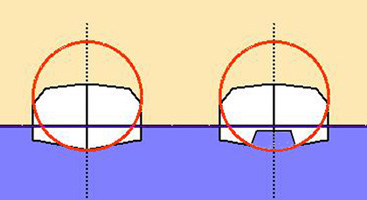
Regular Mono Hull Tunnel Mono Hull
Tunnel hull kayaks are not true (full) catamaran kayaks, and they are not stabler than other monohull kayak hulls (I.E. common SIK and SOT) of similar size and proportions, as will be explained here –
A tunnel hull kayak is another form of monohull (I.E. single hull) kayak – It is not a multihull kayak (see figure 2), so unlike a multihull, the tunnel hull does not distribute more buoyancy on its external sides than a regular monohull does (see figure 2). In other words, most of the tunneled hull’s buoyancy is wasted when it comes to using it to increase its lateral stability, which is also the problem in other monohull designs (E.G. SIK and SOT kayaks).
It’s easy to see that with its sides considerably less buoyant than the sides of a multihull kayak a tunnel hull kayak cannot possibly be as stable.
Primary (Initial) and Secondary Stability in Tunnel Hulls
1. Primary (Initial) Stability:
If the monohull kayak’s tunnel is made deep and wide enough, and its vertical sides have the right form (see example in figure 4) they can act as ‘hard chines’ and thus add some initial resistance to rotational motion. This is far from being comparable to such effect in a real catamaran kayak because the tunnel’s sides are shorter than the boat’s overall length while in a catamaran kayak (E.G. Wavewalk kayak) the hulls’ length is equal to the boat’s overall length.
In stability terms it means that when going on flat water, certain tunnel hulled kayaks could feel more stable than comparable common monohull kayaks, that is offer a little more primary (initial) stability than a traditional SIK or SOT kayak design. However, this potential advantage is likely not to be perceptible since it would be offset by the tunnel hull’s deficiency in buoyancy.
2. Secondary Stability:
A tunnel hull kayak may not provide additional stability for significant weight displacement of its passengers, and it wouldn’t be useful in moving water, waves and other adverse conditions: The secondary stability of a tunnel hull kayak does not exceed that of a regular monohull kayak of the same size and proportions, I.E. it’s considerably less stable than a multihull (true catamaran) kayak.
Ergonomics as a stability factor in small boats
In a tunnel hull kayak the paddler or fisherman sits with their legs stretched forward and their trunk only a few inches higher than the ankles. This position hardly differs from the notoriously non ergonomic L kayaking position, and therefore hardly offers any improvement as far as the ability to use the legs for balancing, control and power generation, while it still forces the passenger to rely on a back rest for support, consequently causing fatigue and discomfort that decrease overall balancing capabilities.
What can a tunnel hull really do to make a kayak better?
Incorporating a tunnel in a monohull design can be an effective means to improve tracking (directional stability), as the tunnel enables water to flow in a straight line (I.E. not deflected or ‘curved’) along the hull, in parallel to the direction of the boat. This can be helpful in very wide monohull canoes and kayaks (E.G.fishing kayaks) that track poorly. However, similarly to a rudder, the tunnel has a negative effect on speed.
Important: A tunnel hull boat is not a multi-hull boat, it is a mono-hull boat that with a bottom that has a different look. Tunnel hull boats are officially classified, sold, and registered as mono-hull (regular) boats, and not as multi-hull boats, namely catamarans.
But both The W720 and S4 are true multi-hull boats, in the full sense, as required by law and by the US Coast Guard, that is having two separate waterlines at all times. The W720 is classified as a multi-hull (catamaran) kayak, and the S4 is a multi-hull (catamaran) boat, and owners of an S4 microskiff register it with the local authorities as a “multi-hull boat” and not as a “boat”
‘What if’ – a quick reality check
Introducing a tunnel in a monohull kayak places the passengers higher than in a regular monohull kayak without having them benefit either from significant increase in stability or significant improvement in their paddling or fishing position.
If the tunnel hull kayak design offered any real advantage in terms of stability it would enable producing narrower (I.E. faster) yet stabler monohull canoes and kayaks. Since in reality the tunnel in the kayak’s underside does not produce such effect, tunnel hull canoes, kayaks and hybrids are among the widest kayak designs on the market.
CONCLUSION: SUPER STABILITY
In comparison to other kayak designs, the Wavewalk kayak design offers both increased initial and secondary stability as well as improved ergonomics resulting in Super Stability: The ability to perform things that are impossible with any other kayak, and an overall better user experience than that offered by all other kayaks, including the widest and most stable ones, as well as kayaks outfitted with outriggers. Such Super Stability is reached in the patented, 31″ wide W720 catamaran kayak-skiff, and it is surpassed only by the 38″ wide S4 Microskiff, the world’s most stable kayak, whose stability surpasses that of bigger and wider boats.
Appendix A
Food For Thought About Truth In Advertising
Well, it’s more of a snack really, but the following anecdote may shed some light on this subject from a different angle – that of ‘marketing hype’:
The tunnel hull design for small, paddle powered watercraft has gained some new life in recent years with one company that promotes it quite energetically.
We found that company’s website describing the tunnel hull as being ‘extraordinarily stable for a single hull boat’, while the same website claims that another small watercraft that company offers ‘incorporates a V hull design to provide stability…’
It doesn’t take a boat designer to realize intuitively that a kayak hull whose cross section is shaped like a deep V is in fact unstable, and the only reason one would incorporate such a form into a hull design is to try and improve its tracking capability, and looks.
Appendix B
More Food For Thought About Truth In Advertising
About Add-On Kayak Outriggers
What is the effect of small outriggers attached to the kayak’s stern?
Generally, small outriggers add some initial stability but little to no secondary stability. This means they give the kayak user some sense of security on flat water, when the kayak not disrupted and not tilting on its side, but this sense of security is misleading, since a small outrigger is not sufficiently buoyant to support the heavy weight applied on it as soon as the kayak tilts on its side, and therefore such outrigger may not prevent an accident.
Practically speaking, as soon as the kayak user seriously loses balance, for example in case they’re attempting to stand up, or if the kayak is hit by a motorboat’s wake, they cannot rely on extra lateral stability that would be enough to prevent their kayak from tilting further. This problem is particularly acute in SOT kayaks, since their user is already seated or attempting to stand on a deck that’s several inches above waterline, and therefore they’re insecure and less stable to begin with.
Appendix C
The “Leaning Bar” on fishing kayaks and microskiffs-
Some large-size SOT fishing kayaks, including the one discussed in the previous paragraph feature a tall vertical metal frame dubbed “leaning bar” or “lean bar”. This is also true for some small microskiffs, whoch are essentially motorized paddle boards. The leaning bar is supposed to provide some support for the angler who’s either driving standing or attempting to fish standing up.
Practically, such vertical metal frame adds leverage to the angler’s weight if they lean on it or grab it, which can cause the kayak tilt further in case the angler loses balance and the kayak is tilting sideways.
Again, Wavewalk’s is the only fishing kayak design that offers fishermen to stand up and fish with 100% confidence and safety.
Appendix D
Stability in Motorized Kayaks
Many kayak anglers reach the conclusion that paddling or pedaling alone is an insufficient means of propulsion, both in terms of safety and the limits it imposes on one’s range of travel. Most of these people outfit their kayaks with an electric trolling motor, which is an acceptable solution, since such motors are not powerful enough to generate much speed.
Some kayak manufacturers and outfitters attempt to mount outboard gas motors on kayaks, and the results seen on YouTube videos make one wonder about the limits of human reason…
In essence, the common kayak form is pointed on both ends, and outboard motors work best when stern mounted. Practically, mounting a motor at the kayak’s rear end puts it too far from the driver to allow for an acceptable level of comfort and safety. Starting, shifting gears and steering are awkward at best, and dangerously compromised.
Those videos may have an entertainment value, but this is where their value ends, since they do not reflect real world conditions.
More information about motorizing kayaks »
Do you have any questions for us?


